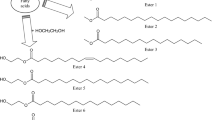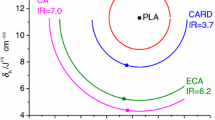Abstract
Plasticized systems of poly-β-hydroxybutyrate (PHB) are studied, where low-molecular compounds traditionally used for this purpose for various systems, i.e., dioctyl sebacate, dibutyl sebacate, polyethylene glycol, Laprol 503, and Laprol 5003, are used as plasticizers. All of them are nontoxic and biodegradable compounds with a similar molecular weight and comparable polarity of molecules. The main purpose of this study is to improve the deformability of PHB taking into account the structural changes in plasticized PHBs. The plasticizers chosen are completely compatible with the polymer and form a monophase system up to a plasticizer content of 15–20%. An increase in the plasticizer content allows us to increase efficiently the deformability of the polymer (the relative breaking elongation of PHB at room temperature grows up to 250–300%). At the same time, the system becomes considerably weaker and therefore there is no point in increasing the concentration of plasticizers by more than 20 wt.%. According to the data obtained from DSC measurements, the ratio between the amorphous and crystalline regions of PHB in the presence of plasticizers mentioned remains practically constant. The changes in the elastic properties of PHB/low-molecular plasticizer systems are mainly due to efficient weakening of intermolecular interactions in the amorphous regions of the polymer. A slight decrease in the crystalline order of PHB is of secondary importance.
Similar content being viewed by others
References
D. Hutmacher, M. B. Hurzeler, and A. Kirsch, “The effects of gamma and ethylene oxide sterilization on different bioresorbable polymers,” in: 5th World Biomaterials Congr., Toronto, Canada (1996).
G. J. L. Griffin, Chemistry and Technology of Biodegradable Polymers, Chapman & Hall (1994).
M. Yasin and B. J. Tighe, “Polymers for biodegradable medical devices. VIII Hydroxybutyrate-hydroxyvalerate copolymers: physical and degradative properties of blends with polycaprolactone,” Biomaterials13, No. 1, 9–16 (1992).
P. J. Barham and S. J. Organ, “Mechanical properties of polyhydroxybutyrate-hydroxybutyrate-hydroxyvalerate copolymer blends,” J. Mater. Sci.,29, 1676–1679 (1994).
J. S. Yoon, C. S. Choi, and S. J. Maing, “Miscibility of bacterial poly-D(-)(3-hydroxybutyrate) in poly(ethylene oxide) and poly(methyl methacrylate),” Eur. Polym. J.,29, No. 10, 1359–1364 (1993).
E. Blumm and A. J. Owen, “Miscibility, crystallization and melting of poly(3-hydroxybutyrate)/poly(L-lactide) blends,” Polymer,36, No. 21, 4077–4081 (1995).
E. Martuscelli, B. Marcandalli, M. Canetti, A. Seves, and P. L. Beltrame, “Crystallization and thermal behaviour of poly-D(-)(3-hydroxybutyrate)/poly(epichlorohydrin)blends,” Polymer,34, No. 5, 996–1001 (1993).
P. Xing, L. Dong, M. Avella, and E. Martuscelli, “Miscibility and crystallization of poly(b-hydroxybutyrate) and poly(p-vinylphenol) blends,” Macromolecules,30, 2726–2733 (1997).
G. Tomasi and M. Scandola, “Blends of bacterial poly(3-hydroxybutyrate) with cellulose acetate butyrate in activated sludge,” J.M.S. Pure Appl. Chem., A32(4), 671–681 (1995).
G. Ceccorulli, M. Pizzoli, and M. Scandola, “Plasticization of bacterial poly(3-hydroxybutyrate),” Macromolecules,25, 3304–3306 (1992).
K. Tinius, Plasticizers [Russian translation], Khimiya, Moscow (1964).
E. M. Stegantseva, L. Savenkova, and Y. H. Park, “Effects of nitrogen and oxygen supply on production of poly-b-hydroxybutyrate inAzotobacter chroococcum,” J. Microbiol. Biotech., 5, No. 2, 100–104 (1995).
I. Bibers and M. Kalnins, “Control of biopolymer poly-b-hydroxybutyrate characteristics by γ-irradiation,” Mech. Compos. Mater.,35, No. 2, 169–178 (1999).
R. Pearce and R. H. Marchessault, “Multiple melting in blends of isotactic and atactic poly(b-hydroxybutyrate),” Polymer,35, No. 18, 3990–3997 (1994).
Additional information
Institute of Polymer Materials, Riga Technical University, Riga, LV-1048, Latvia. Translated from Mekhanika Kompozitnykh Materialov, Vol. 35, No. 4, pp. 527–538, July–August, 1999.
Rights and permissions
About this article
Cite this article
Bibers, I., Tupureina, V., Dzene, A. et al. Improvement of the deformative characteristics of poly-β-hydroxybutyrate by plasticization. Mech Compos Mater 35, 357–364 (1999). https://doi.org/10.1007/BF02259726
Received:
Revised:
Issue Date:
DOI: https://doi.org/10.1007/BF02259726




